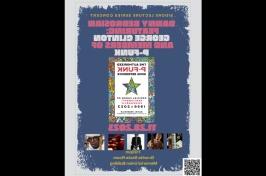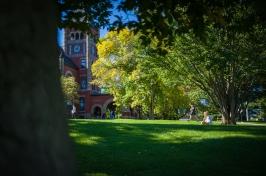
Somali brother and sister, Manchester, 2013. (Becky Field, Fieldwork Photos)
As the time approached for final projects to be completed in the photography program Becky Field had enrolled in at the New Hampshire Institute of Art (now New England College), she knew many of her classmates were frantically scrambling to pull project ideas together.
She, though, was experiencing no such pressure.
“Many students probably started their final projects two weeks before we ended the program, but I had started mine two years ahead,” she laughs.
She’d been struck by hateful graffiti scrawled on the sides of four refugee homes in Concord between 2011 and 2012. She’d just begun the photography program – a “retirement project” after more than two decades as a university professor and research ecologist for the federal government – when she decided to document the lives of new Americans in New Hampshire through her photography as a way to counter the hate.
“I got angry about that graffiti – it was written on the homes of people who had fled very dangerous and threatening situations to come here and find safety, and here they were being threatened by these words,” Field says. “So I decided to use my camera as a way to say, ‘You are welcome here, I see the contributions you are making to our communities and you are an important part of our society.’”
That two-year head start on her final assignment has turned into a 12-year-long passion project. Field has long since matriculated from the photography program, but her body of work, “Different Roots, Common Dreams; New Hampshire’s Cultural Diversity” continues to grow, and she recently celebrated a key milestone when UNH’s Dimond Library established a publicly accessible archive of digital images from her project.

The archive, housed in the Dimond Library’s Milne Special Collections and Archives, is searchable and accessible to the public through the UNH Scholars Repository, a searchable online collection of scholarly and creative works collected by the library.
“Becky has done so much to bring awareness to the experience of immigrant communities in New Hampshire," says Eleta Exline, scholarly communication librarian, who is responsible for the development of library digital collections. "Her work is beautiful, and we’re so excited to be able to include it in our digital collections."
Given her path to getting behind the camera following decades in other fields, having her photography archived at UNH has been exciting for Field.
“If 15 to 20 years ago you’d have said, ‘Guess what? You’re going to be a fairly well-known photographer in New Hampshire photographing immigrants,’ I would have said ‘You are crazy,” she admits.
Field made her first contacts with New Hampshire’s immigrant communities through the leadership of nonprofit groups that support new Americans. Those leaders introduced Field to English classes in the area and families willing to participate. Initially her work was primarily in Concord, Nashua and Manchester, where most of the state’s refugee resettlement programs were active.
The project’s reach expanded over time, though, as word spread to others in refugee communities who were not only willing but excited to take part. The archive collection now includes photographs from many areas of the state, including the North Country.
Field has continued to add to the collection since its inception.
“A lot of the immigrant families got so excited, they loved having their pictures taken. Many of them expressed to me how they felt like they were finally being seen, being recognized, being acknowledged and being included as part of the community,” Field says.
The archive collection is not the only work Field has done to highlight immigrant communities in New Hampshire – in fact, it’s not even the only such project at the Dimond Library. Field also has an exhibit of large photographs depicting the story of one African man who was jailed for two years after legally seeking asylum in 2018. After COVID broke out, he was moved into a home in the New Hampshire Seacoast area, where he remained under house arrest and tracked with a GPS monitor for an additional three years.
In March 2021, Field wanted to continue her focus on the refugee population but was interested in doing an in-depth series of photographs around one person. She spent a year and a half visiting this asylum seeker weekly, documenting his daily life through portraits and growing to become good friends.

Though the subject of New Hampshire’s immigrants is similar, the resulting exhibit, Crying in the Wilderness: An Immigrant’s Journey in Detention, is a departure from her other work in many ways, most notably because of the lack of vibrant color. All of the photographs are black-and-white, printed on canvas that is 4 feet by 5 feet, suspended inside black metal frames that are even larger.
“This is quite different from all the other work I’ve done,” Field says of the exhibit, which will hang in the Milne Room of the library until Jan. 27, 2024. “The display is unique – several people have told me they’ve never seen an exhibit quite like it before.”
The exhibit is supported by the UNH Library and is funded by UNH's department of anthropology and the UNH Center for Humanities, as well as the New Hampshire State Council on the Arts.
Field was quick to praise the staff at Dimond Library for helping coordinate and install the current exhibit, as well as the digital archive.
“I can’t say enough good things about the library staff, they’ve been wonderful collaborators on all of this,” Field says. “The years of work on this project have been very rewarding for me. I hope that my photography also leaves a lasting impression on viewers and provides a meaningful view of New Hampshire’s vibrant and valuable diverse communities.”
-
Written By:
Keith Testa | UNH Marketing | keith.testa@mblayst.com






















































